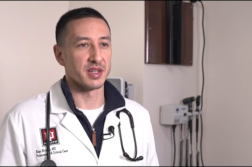SEATTLE, Wash. (Ivanhoe Newswire) — Results from several clinical trials combining chemo and immunotherapy changed the standard of care for many lung cancer patients last year. The chemo kills the cancer cells, and the drug prompts the immune system to do its job. Lung cancer treatment
Rider, snowboarder, climber Jim Brown still tears it up on his electronic mountain bike. Today, with daughter, Isabella.
Brown said, “I’m the last person in the world that people would think would get lung cancer. And it was pretty shocking.”
Carcinogen exposure from Brown’s 25-year firefighting career is blamed for his stage four adenocarcinoma lung cancer, diagnosed in 2015. He enrolled in Keynote 21, a trial that added Keytruda to standard chemo for some participants. He didn’t get the Keytruda, but the chemo kept his disease stable for 22 months. Christina S. Baik MD, MPH, Seattle Cancer Care Alliance at University of Washington School of Medicine helped with the combination drug trial, which became the standard of care for many lung cancer patients last year.
Dr. Baik said, “All patients who don’t have a specific genetic mutation are receiving this drug combination of chemo and pembrolizumab as first treatment.”
Brown does have a genetic mutation. He entered a trial for lorlatinib, a targeted drug that got FDA approval soon after.
“It’s progression of medicine, and unless people are willing to do clinical trials, we can’t move forward,” said Brown.
“This is a mechanism by which patients are getting treatment of tomorrow. I think that’s one thing that we like to say here, that you’re getting a treatment of tomorrow,” stated Dr. Baik.
Brown is already in another trial comparing blood markers to CT scans to track disease progression.
Brown is still working in the firehouse. He is passionate about educating other firefighters on how to minimize exposure to carcinogens. Dr. Baik says many patients don’t benefit from these drug combinations, so there’s lots of room for research there.
Contributors to this news report include: Wendy Chioji, Field Producer; Rusty Reed, Videographer; Cyndy McGrath, Supervising Producer; Roque Correa, Editor.
To receive a free weekly e-mail on Medical Breakthroughs from Ivanhoe, sign up at: http://www.ivanhoe.com/ftk
MEDICAL BREAKTHROUGHS
RESEARCH SUMMARY
TOPIC: NEW FIRST- LINE TREATMENT FOR LUNG CANCER
REPORT: MB #4657
BACKGROUND: Most lung cancers are non-small cell lung cancers, and most non-small lung cancers are adenocarcinomas. This form of lung cancer accounts for more than 30 percent of all lung cancers and about half of all non-small cell lung cancers. Adenocarcinoma forms in glands that secrete mucus. Other than the lungs, adenocarcinoma is most prevalent in cancers found in the prostate, pancreas, esophagus, colon and rectum. In the lungs, adenocarcinoma tumors most often form in the alveoli, the tiny balloon-like sacs that help pump air in and out of the lungs. The symptoms of adenocarcinomas in the lung include: persistent cough, shortness of breath, chest pain, raspy voice, cough that produces blood, and unexplained weight loss.
(Source: https://www.cancercenter.com/cancer-types/lung-cancer/types/adenocarcinoma-of-the-lung)
TREATMENT: About one-third of lung cancer patients are diagnosed with localized disease that may be treated by either surgical resection or, if the patient is not a candidate for full surgical resection, with definitive radiotherapy. Another third of patients have disease that has already spread to the lymph nodes. In these cases, radiation therapy along with chemotherapy and occasionally surgery is used. The last third of patients may have tumors that have already spread to other parts of the body via the blood stream and are typically treated with chemotherapy and sometimes with radiation therapy for the relief of symptoms.
(Source: https://www.radiologyinfo.org/en/info.cfm?pg=lung-cancer-therapy)
NEW RESEARCH: Christina S. Baik MD, MPH, from the Seattle Cancer Care Alliance at the University of Washington School of Medicine talks about how drug trials are important to find the best options for different patients, “A lot of times the effectiveness with just one drug is not very high. So we are looking towards combining with other drugs to look for synergy. But at the same time there are two sides to the coin, right? The more drugs we add, the more side effects there are. In clinical trials there are two things we’re always looking for – is it working for patients? But at the same time are we able to preserve the quality of life of those patients and not making patients too sick from all the side effects? One thing I usually tell my patients is that we want to make sure that the treatment is not worse than the cancer itself, right? So at the end of the day while we’re trying to achieve is that patients are able to live a relatively normal life with their cancer, which means that we want to make sure that the side effects are acceptable at the same time as improving the effectiveness.”
(Source: Christina S. Baik MD, MPH)
FOR MORE INFORMATION ON THIS REPORT, PLEASE CONTACT:
Melissa Roa
855-557-0555
If this story or any other Ivanhoe story has impacted your life or prompted you or someone you know to seek or change treatments, please let us know by contacting Marjorie Bekaert Thomas at mthomas@ivanhoe.com




